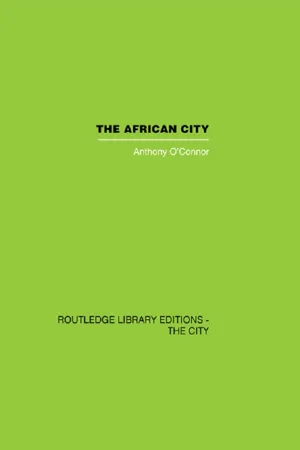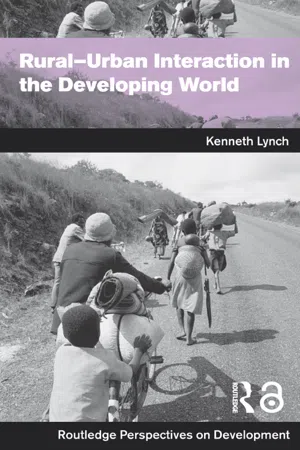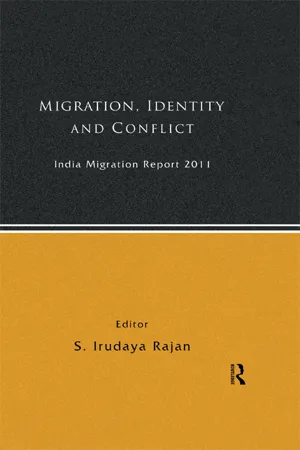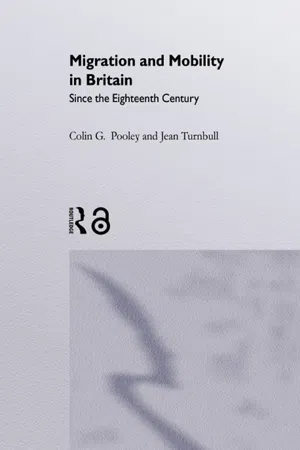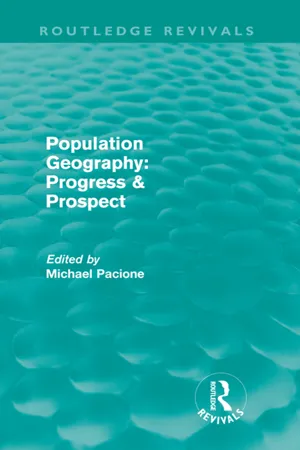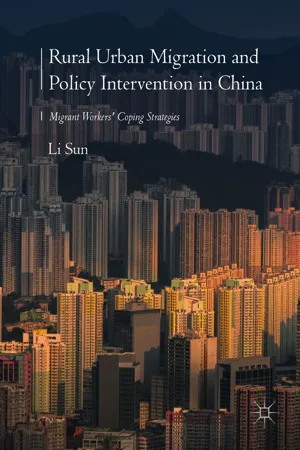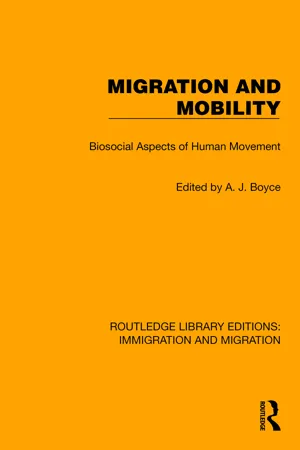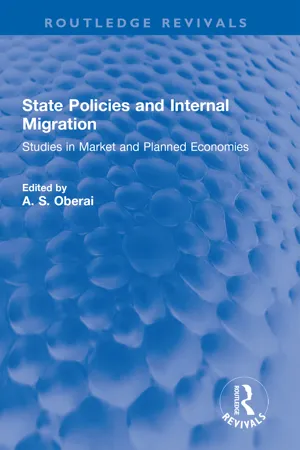Geography
Rural to Urban Migration
Rural to urban migration refers to the movement of people from rural areas to urban areas in search of better employment opportunities, improved living standards, and access to services. This demographic shift has significant impacts on both the areas of origin and destination, including changes in population distribution, urbanization, and strain on urban infrastructure and resources.
Written by Perlego with AI-assistance
Related key terms
Related key terms
1 of 4
Related key terms
1 of 3
12 Key excerpts on "Rural to Urban Migration"
- eBook - ePub
- Anthony O'Connor(Author)
- 2013(Publication Date)
- Routledge(Publisher)
3 Rural–urban migration
Until very recently migration was the chief contributor to total urban population growth in most parts of Africa: it remains everywhere the chief cause of a rising level of urbanization. Even today in most African cities there are far more migrant than local-born adults, and in relation to the size of the existing urban population the scale of such migration is greater than in any other part of the world. Net migration out of certain rural areas has actually reduced their population, as in parts of Zambia, although rural natural increase is too high, and the urban share of the total population too low, for this yet to be widespread.Population movements are constantly occurring throughout Africa, as they have always done (Prothero 1968, Gould and Prothero 1975, Clarke and Kosiński 1982). Prior to this century few were focused on cities, for even where these existed they grew mainly by natural increase. Today rural–to–urban movement is the dominant element in long-distance migration in most countries, though rural–rural local movements (for example, for marriage) may involve even more people.In examining rural–urban migration we are concerned with its extent, nature, causes and consequences, but all too little is known about each of these. Even the simple rate of net in-migration, either at present or in the recent past, is not known for any city. Subtracting a presumed rate of natural increase from total population growth provides only a crude indicator, even after allowing for births to recent migrants. Census data on birthplace are relevant for past movements, though influenced by such factors as women returning to the rural home area for childbirth. One might compare the size of each age group at the latest census with the size of the group ten years younger at a census ten years earlier, allowing for deaths: but truly comparable data are rarely available, age is often mis-reported, and even school terms and holidays may distort the figures. - eBook - ePub
- Brian W. Ilbery(Author)
- 2014(Publication Date)
- Routledge(Publisher)
PART 3 CHANGING RURAL ECONOMY AND SOCIETYPassage contains an image CHAPTER 7 RURAL MIGRATION AND DEMOGRAPHIC CHANGE Gareth Lewis
INTRODUCTION
Migration, or the movement of people from one geographical location to another, has increased in volume and diversity over time and involved steadily lengthening distances. With the emergence of a world economy and the globalization of communications, migration in turn has ‘exploded’ at all geographical scales and become of major concern, thus justifying Goldstein’s (1976, p. 424) observation that, ‘whereas the study of fertility dominated demographic research in the past several decades, migration may well have become the most important branch of demography in the last quarter of the twentieth century’. In order to enhance an understanding of these expanding migratory flows, Zelinsky (19710) has linked them to the process of modernization in such a way that different types of migration could be seen as being characteristic of different stages of development. The model highlights two significant transformations in the redistribution of population since 1850: first, during the late nineteenth century the concentration of population, or urbanization, consequent upon the advance of industrialization, into a limited number of areas; and second, during more recent decades, a rather different and what some have regarded as an unexpected trend, whereby ‘a number of major centres of population concentration in the industrial nations began to experience a decline in the in-movement of population from the more remote and peripheral regions of those nations. This decline has continued … and in many places has gone as far as to create a net flow of population out of major conurbations back into the peripheral and predominantly rural regions’ (Vining and Kontuly, 1978, p. 49).Significantly, the reversal in the fortunes of rural populations has had very different implications to those of urbanization for both the settlement system and the social system. For example, Rowland (1979) and Wardwell (1977) in Australia and the United States, respectively, suggested that migration maintains rather than modifies a settlement system. Essentially, migration is viewed as an equilibrium-seeking process, so that ‘migration equilibrium may be approached towards the end of the mobility transition as all parts of the settlement system achieve a high level of modernization’ (Rowland, 1979, p. 11). Similarly, in its role as an agent of social change, migration also tends to reduce the difference in the culture, lifestyle and composition of urban and rural populations (Pahl, 1966; Lewis, 1979). Effectively, contemporary rural migrations reinforce what Parker (1970, p. 4) has described as the postwar ‘social avalanche which swept away the last traces of ‘village life’ and transformed life for everybody, everywhere. … There is no point whatsoever in talking any longer about ‘village life’ and ‘farm life’. It’s just life.’ - eBook - ePub
- Kenny Lynch(Author)
- 2004(Publication Date)
- Routledge(Publisher)
There is a clear pattern of population growth in most cities in the developing world. The evidence discussed in this chapter suggests that this is a result partly of natural growth – people being born in cities – and partly in-migration from rural areas. The UNFPA (1996) suggests that the relative contribution of each to urban growth is equal. However, beyond this, the picture becomes complex. There is evidence to suggest that migration between urban and rural areas involves large numbers and can go in both directions. In some cases, circulatory migration is a key part of both household and individual livelihood strategies. Some households adopt a strategy ensuring they have access to both urban and rural locations in order to take advantage of the complementary livelihood opportunities in each. For example, urban living appears to focus on social networks which provide opportunities for market-based activities, while kin and family ties – although breaking down in some locations – still constitute important rural social networks. There is evidence to suggest that under certain conditions – in particular conditions of economic adversity – the net flow of migrants may turn from rural to urban to urban to rural, as city dwellers flee adverse circumstances in search of a rural safety net.Discussion questions
- Review the different forms of migration that are described in the literature on rural–urban population movements.
- Critically assess the role of the state in the management of migration between cities and the countryside in the developing nations.
- Review the main motivations for migrating from the rural areas to the city. Review the evidence for motivation to move from the city to the countryside.
Suggested reading
de Haan, A. (1999) Livelihoods and poverty: the role of migration – a critical review of the migration literature. Journal of Development Studies 36 (2), 1–47.Potts, D. (1995) Shall we go home? Increasing urban poverty in African cities. Geographical Journal 161 (3), 245–264.Zhu, Y. (2000) In situ urbanization in rural China: case studies from Fujian Province. Development and Change - eBook - ePub
India Migration Report 2011
Migration, Identity and Conflict
- S. Irudaya Rajan(Author)
- 2012(Publication Date)
- Routledge India(Publisher)
3The paper by Lall, Selod and Shalizi (2006) synthesizes the current state of knowledge concerning internal migration in developing countries. They provide a policy-oriented survey of the research carried out on internal migration in developing countries over the past five decades. Some of the questions around which they summarize the findings relate to how internal migrants behave at different stages of the migration process, how do migrants prepare for migration, how do they migrate, what are the difficulties they face on arriving in urban areas and what links do they maintain with rural areas? Keeping in view this exhaustive review, we do not wish to repeat the issues here. We turn to the empirical content of the paper in the following sections.Urban Growth and Rural-to-Urban MigrationPopulation in the urban areas expands due to the following three factors: natural growth of population, rural-to-urban migration and reclassification of rural areas as urban in course of time. Around two-fifth of the total urban growth in the Third World is accounted by the rural-to-urban migration (Gugler 1988). The process can be identified as ‘over-urbanization’ as long as (a) rural–urban migration leads to a misallocation of labour between rural-and-urban sectors in the sense that it raises urban unemployment, underemployment and poverty, and (b) rural–urban migration increases the social cost for providing for a country’s growing population (ibid.).With a significant fall in the mortality rate, the natural growth of urban population has grown at a high level thus raising the long-run supply of labour substantially. In fact, in developing countries the natural growth of urban population is not significantly lower than its rural counterpart although fertility rate declined considerably in most of the developed countries because of significant changes in the socioeconomic life-styles of the urban population. In the Indian case although the urban birth and death rates are found to be much lower than their rural counterparts for the periods 1971–1980 and 1981–1989, the urban rates of natural increase were only marginally lower than the rural rates. As can be seen from Table 3.1 - Colin Pooley, Jean Turnbull(Authors)
- 2005(Publication Date)
- Routledge(Publisher)
This chapter examines a series of specific hypotheses about the extent, nature and characteristics of migration between places of different size. First, to what extent was Rural to Urban Migration, and movement from small towns to large towns, a dominant and consistent process in all British regions in the period after 1750? Second, were flows of migrants towards urban centres matched by coumterflows away from such places to other towns and rural areas? Third, to what extent did the selective characteristics of rural to urban migrants lead to the transfer of a younger population to towns and thus, it can be argued, the migration process effectively shifted rural fertility to towns and contributed to the high rates of natural increase in urban centres? Fourth, how important were migration experiences other than rural to urban moves, including processes of counter-urbanization, rural circulation and intra-urban residential mobility? By examining the totality of the migration experience over the 200 years from 1750, it should be possible to place assumptions about the significance of rural to urban moves in a wider context and resolve some of the apparent contradictions that emerge from earlier work.One of the problems associated with studying the significance of rural to urban movement lies in the arbitrary nature of rural and urban definitions. Studies of urbanization in nineteenth century Britain have adopted criteria of population size, sometimes backed up by evidence on population density and degree of nucleation. It is argued that such measures can, to some extent, be used as surrogates for, otherwise unavailable, data on urban functions (Law, 1967; Robson, 1973). However, there is no ready agreement about the size threshold that should be used to determine an urban settlement (Carter, 1995, pp. 10–17), and concepts of rurality are as elusive as definitions of urban settlements (Cloke and Edwards, 1986; Cloke, 1994). In this analysis implications about the degree of rurality or the extent of urban functions associated with particular settlements are avoided. Movement between settlements is assessed purely on the basis of population size, to examine the degree to which movement was mainly from small to larger places or vice-versa.- Michael Pacione(Author)
- 2013(Publication Date)
- Routledge(Publisher)
6 Young Latin women thus are potentially mobile independent of a spouse. Faced with limited rural opportunities, they turn to the cities where many households can afford to offer them the low pay and limited benefits that go with domestic service. Everywhere young adults are the most likely to move because they are at a transitional stage between adolescence and adulthood, but the length of this stage varies a good deal across cultures –especially for women.Patterns of MigrationThe movement of individuals is the focus of much migration analysis. This tendency is encouraged by the fact that migration frequently involves young single persons. However, in many cases migration is not just a once for all move, rather there are a number of moves over a lifetime. Such a migratory career is best understood with reference to family and community. Three principal patterns of rural-urban migration in the Third World then stand out: (a) temporary migration of men; (b) family migration to urban areas followed by return migration to the community of origin; and (c) permanent settlement.These are not fixed statuses. The man who left his family behind may decide to have them join him; the family that expected to return to its community of origin may settle down in the city forever. While changes in migratory status, as perceived by the migrant, typically go in the direction of an increasing commitment to the place of destination, they are clearly affected by changing circumstances in both the urban environment and the area of origin, e.g. deteriorating urban conditions may force men to send their families back to the village.The preponderance of men over women in net rural-urban migration in South Asia, in much of Subsaharan Africa, and in Oceania (Ferree and Gugler 1985) reflects the tendency of male migrants to leave wife and children in their rural area of origin. If the Industrial Revolution engendered the distinction of workplace and home, the separation of worker and dependents has been drastically magnified for many Third World families. Extended family support typically facilitates such simultaneous involvement in the urban and the rural economy. Indeed, the assistance of male kin in certain tasks, and the protection they afford, frequently appears as a prerequisite for a wife to manage the farm and to hold her own in a male-dominated environment.- eBook - ePub
Rural Urban Migration and Policy Intervention in China
Migrant Workers' Coping Strategies
- Li Sun(Author)
- 2018(Publication Date)
- Palgrave Macmillan(Publisher)
Since various governments adopt instruments to shape rural–urban migration, governments can and have a significant impact on the flows of migration currently as well as historically. For example, there exists a complex household registration system in Vietnam, where residents’ statuses are classified into four types: KT1, KT2, KT3, and KT4. Generally speaking, only Vietnamese residents having KT1 registrations are qualified to work in cities (Deshingkar and Natali 2008). Similarly, in China, rural–urban migration was firmly controlled by the government through the hukou system between 1950 and 1980s when rural residents with an agricultural hukou cannot easily migrate to cities for employment. Although the system is still presently in place in China, it is less restrictive, and while it does not stop rural migrants from migrating, it does limit their rights to social services in the receiving area. 2.1.4 Mabogunje’s Systems Approach to Rural–Urban Migration Mabogunje (1970) defines rural–urban migration as “a basic transformation of the nodal structure of a society in which people move from generally smaller, mainly agricultural communities to larger, mainly non-agricultural communities.” In addition to this spatial (horizontal) aspect of migration, there is a socioeconomic (vertical) aspect, which refers to “a permanent transformation of skills, attitudes, motivations, and behavioral patterns such that a migrant is enabled to break completely with his rural background and become entirely committed to urban existence.” Mabogunje highlights a permanent transformation as the core of migration. Mabogunje proposes to study migration within the framework of general systems theory. He indicates rural–urban migration does involve not only people who migrate but also some complex interacting elements, together with their attributes and relationships (Mabogunje 1970, 3) - eBook - ePub
Migration and Mobility
Biosocial Aspects of Human Movement
- A.J. Boyce, A.J. Boyce, A.J. Boyce(Authors)
- 2022(Publication Date)
- Routledge(Publisher)
INTER-URBAN MIGRATION IN BRITAIN: A GEOGRAPHICAL PERSPECTIVE
J.H. JOHNSONDepartment of Geography, University of Lancaster, Bailrigg, Lancaster LA 1 4YW, UKINTRODUCTION
As societies, economies and transport systems become modernized, then more frequent, longer, and more complex movements of population commonly take place. As this spatial mobility of population grows, the resulting diverse movements of population become more and more difficult to fit into an easy typology; but a critical distinction must be made between temporary movements connected with everyday activities and those moves which involve a change of home, with the social and economic costs that this entails (figure 1 ). Not that the two types are independent, since temporary movements provide the opportunity to acquire the information which may lead to permanent migration. For example, retirement moves are often made to resort areas known earlier in life and intra-urban residential moves are frequently made to sectors of the city which are known for other reasons. Focusing on permanent moves (in so far as the term ‘permanent’ can be applied to any population movement in modern urban society), a critical distinction is between those moves which simply involve a change of residence and those which also involve a change in employment (Johnson 1976 ). The study of ‘ labour migration’ – the simultaneous change of job and of home – has taken on greater importance in recent decades for a number of inter-related reasons.FIGURE 1. Some types of population migration.Reduced levels of fertility are leading to parallel falls in natural increase in many parts of the developed world. In Britain, it is likely that the period of relatively rapid population increase since the end of World War II is at last at an end. As a result, population migration of all types is becoming more important in causing changes in population totals and in modifying local population structures. The importance of migration is not merely demographic. In the past many regionally based planning proposals have often assumed that natural increase would more than offset loss by migration. This assumption has usually proved to be true, at least as far as the population totals of major regions are concerned, although not necessarily at a local scale. It could be quite confidently expected that planning errors in the over-provision of houses or jobs could be corrected in the longer term, as total regional population grew. Now, however, mistakes in the allocation of regional investment appear more difficult to adjust (Johnson & Salt 1981 - eBook - ePub
- Cecilia Tacoli(Author)
- 2018(Publication Date)
- Routledge(Publisher)
This has adversely impacted on the 900,000 rubber growers in Kerala of whom 90 per cent are small farmers with less than 2ha of land. 5 Similar stories are being reported about tea, groundnuts, rice and many other commodities that were previously remunerative. But there are few other academic studies in this area because it has emerged very recently. Press coverage however, has been extensive. 6 More research is urgently needed in this area. The ‘pull’: New opportunities in urban-based industry and services In the 1950s, development economists viewed the demand for labour created by ‘growing modern industrial complexes’ and the gap in rural and urban wages as the main ‘pull’ factor. There have since been many models and debates on what motivates people to migrate including theories of ‘expected’ as opposed to actual wage differentials. Other pull factors include the desire to acquire skills or gain new experiences. In the case of voluntary migration of the poor for economic reasons, the wage gap is probably the most important pull and the most important recent determinants of this appear to be urbanization and the spread of manufacturing. Urbanization Urbanization has become a major driver of internal migration Rates of urbanization influence rural–urban wage differences: an increase in the demand for labour in urban areas can push up urban wages and increase migration. Rural–urban differences in average incomes increased in many South and East Asian countries during the 1990s, especially in China and fell in most African countries (IFAD, 2001; Eastwood and Lipton, 2000). Current Economic and Social Commission for Asia and the Pacific (ESCAP) projections are that urbanization rates in South and south-west Asia will soon exceed other regions in Asia (Guest, 2003). This is already beginning to be reflected in the growing importance of rural–urban migration - eBook - ePub
Britain's Population
Demographic Issues in Contemporary Society
- Steven Jackson(Author)
- 2013(Publication Date)
- Routledge(Publisher)
Other factors which influence patterns of inter-regional movement include population structure. Life-cycle stage is significant in determining who will move and when. A significant amount of migration occurs at ‘transitional’ phases in people’s lives – particularly at the transition between education and employment and the transition between employment and retirement. Young adults are the most mobile group in the population, not only because of the diverse opportunities available for entry into the labour market, but also because of their general lack of commitments of home ownership and family rearing. As a consequence growth regions tend to attract a disproportionate share of young adults, and localities which are losing numbers become unbalanced in their structure. The destinations for retirement migrants similarly reflect the effects of age-specific migration, with an increasing burden placed on the health and social services for the care of an ageing population.Intra-regional mobility
Patterns of population movement between the regions may reflect the longerterm process of population redistribution in Britain. However, the majority of moves are over relatively short distances. Over 70 per cent of moves in Britain are over distances of 10 km or less – most of which would come under the heading of residential relocation rather than migration (Owen and Green 1991). People move house for a variety of reasons, depending on individual circumstances, but it is possible to identify aggregate patterns of movement from the overall volatility of local moves. One of the wellestablished trends is the process of ‘suburbanization’, brought about by a constant drift of population from the central areas of towns and cities towards newer housing developments on the periphery. This is not a new process and can be identified in Britain from the peak period of urban growth in the nineteenth century. - eBook - ePub
State Policies and Internal Migration
Studies in Market and Planned Economies
- A. S. Oberai(Author)
- 2022(Publication Date)
- Routledge(Publisher)
In the period 1946–78 the urban population – according to census data – went up by 12.6 million persons, which means that it grew at an average rate of 3 per cent per annum. The important factors which influenced this growth were: natural increase; migration from rural to urban areas; and administrative changes, in that order. Up to 1950 and after 1965, however, the main factor in urban population growth was migration from rural to urban areas, whereas in the years 1950–65 the urban population grew mainly under the impact of its own natural growth. (iii) Age and sex of migrants Like movement of people from agricultural to non-agricultural activities, rural-urban migration is selective with respect to age, although in the case of the latter the selectivity is relatively weaker. The data in table 20 show that juveniles and young people aged below 30 had a relatively higher propensity to migrate. This refers both to gross migration flows and to net migration between rural and urban areas. However, within this general pattern there were certain changes in age selectivity in the post-war years which are worth noting. Table 20 : Rural-urban migration rate by age and sex, 1952–78 (per 1,000 rural population) Age/sex 1952–1953 1955–1956 1960–1961 1965–1966 1970–1971 1975–1976 1977–1978 Migration from rural to urban. areas Total 23.9 21.4 19.2 15.3 17.7 23.2 22.5 0–13 13.4 11.9 11.7 10.7 13.5 19.5 20.0 14–17 43.2 34.5 25.2 9.8 8.7 8.5 8.5 18–24 65.8 62.5 67.6 49.9 47.8 56.8 48.8 25–29 42.7 41.8 40.7 41.4 49.9 69.9 67.4 30–44 16.2 15.5 14.2 11.6 14.2 18.8 20.4 45–59 8.6 8.0 7.4 6.0 4.8 7.2 8 60+ 10.1 9.3 11.2 10.1 10.7 10.7 10.2 Males 24.1 22.6 19.6 14.5 16.6 21.5 21.1 Females[-. -=PLGO-SEPARATOR=--]23.7 20.3 18.8 16.0 18.7 24.9 23.8 Migration from urban to rural - eBook - ePub
- John Caldwell, Allan Hill, Valerie J. Hull(Authors)
- 2023(Publication Date)
- Routledge(Publisher)
Inconsistent findings throughout the literature on the incidence and magnitude of such flows, as well as regarding the proportion of senders and recipients, may be more a reflection of the adopted research design than actual remittance practices. By adopting a case study approach focusing simultaneously on rural-to-urban and urban-to-rural remittance flows at both urban and rural ends, we obtain more reliable information. How such empirical migration research has to proceed out of a dialectic between sometimes more than two different levels of analysis, will be discussed by considering the following illustration. As point of analytical entry I shall choose the rural setting from which migration not only originates, but which also may contribute to the particularities of specific mobility patterns. Mobility research throughout developing countries often states that one of the major reasons underlying rapid urban population growth and the fast pace of urbanization can be seen in landless peasants being driven out of rural areas and leaving for town in search of a ‘better’ life. While such observations may undoubtedly be accurate for many areas where feudal systems play(ed) a significant role, it is a known fact in Melanesia that most urban migrants still have access to land in their home areas. 7 That is, we cannot assume a mono-causal relationship between the lack of land as such and the propensity to migrate. Despite access to land, many rural out-migrants in Melanesia find it difficult or impossible to rely on their land to meet an evergrowing demand for cash. In the case of Vanuatu, minimal expenses today affecting all adults are any combination of the following: school fees for children and/or younger siblings (even for primary school), head tax and Church fees, clothing and foodstuffs
Index pages curate the most relevant extracts from our library of academic textbooks. They’ve been created using an in-house natural language model (NLM), each adding context and meaning to key research topics.
Explore more topic indexes
Explore more topic indexes
1 of 6
Explore more topic indexes
1 of 4
